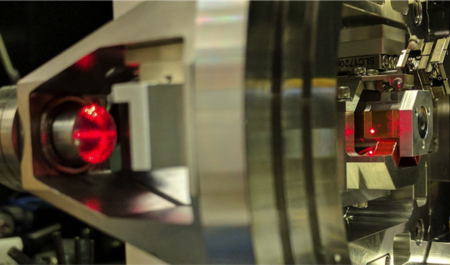The 2018 Klaus Halbach Award for Innovative Instrumentation at the ALS was given to the COSMIC ptychography team “for the development of the microscopy endstation at the COSMIC beamline, featuring an ultra-stable x-ray microscope, computational methods for data reconstruction, and a high-speed data acquisition system.” The award, which was sponsored by Aerotech, Inc., was presented at the ALS User Meeting to team members David Shapiro, Rich Celestre, Kasra Nowrouzi, Bjoern Enders, Young-Sang Yu, Lee Yang, Hari Krishnan, Stefano Marchesini, and the Science IT-HPCS group led by Susan James.

COSMIC (COherent Scattering and MICroscopy), or Beamline 7.0.1, is the newest ALS beamline. Its microscopy branch (7.0.1.2) is designed for ptychography, a type of microscopy in which an image is calculated from coherent scattering data. This removes the resolution restriction placed on the imaging system by the x-ray optics, so that resolution is dependent mostly on the coherent flux. The endstation features Nanosurveyor 2, the most advanced zone-plate-based scanning transmission x-ray microscope at the ALS. COSMIC microscopy combines the capabilities of this microscope with computational methods for reconstructing 3D tomographic and ptychographic data, along with an acquisition system that integrates a Berkeley Lab-developed high-speed detector and fast image processing using multiple graphics processing units. The combination can provide insights into chemical processes in a wide range of materials.

“The team’s outstanding work in microscope design, nano-manipulation, and computational imaging under David Shapiro’s technological and scientific leadership is a perfect example of innovative and scientifically impactful instrument development,” said ALS Interim Science Deputy Andreas Scholl, who nominated the team for the award.
Shapiro, the ALS staff scientist who led the ptychography development efforts, was delighted to receive the honor. “This work was a collaboration among multiple divisions within LBNL—ALS, Computational Research, IT, and Engineering—and our scientific partners in academia. It’s great to work with so many talented people on a complex project and receive recognition for our team effort.”
Paulo Monteiro, a distinguished professor at UC Berkeley who wrote a supporting letter for the award nomination, has worked with Shapiro’s team at the ALS to examine calcium silicate hydrate nanocrystals, which are key to developing advanced cements. Ptychography, he said, is a “game changer” is his field due to the combination of high resolution and less beam damage compared to the more traditional transmission electron microscopy tomography. Members of his research group and the COSMIC ptychography team were awarded the American Ceramics Society’s 2016 Stephen Brunauer Award for applying soft x-ray ptychography to study cement nanocrystals.
Jordi Cabana, an associate professor at University of Illinois at Chicago, and Will Chueh, an assistant professor at Stanford University, also supported the nomination. Both have worked with the ptychography team to study battery electrochemistry.

Cabana was a co-author with Shapiro’s group on a seminal paper in Nature Photonics that reported the record-setting development of soft x-ray ptychography at 5-nm spatial resolution. He continued to work with the group to resolve lithium iron phosphate redox states with 11-nm spatial resolution in 3D, setting a world record for x-ray tomographic imaging using ptychographic reconstruction. Insights into the fundamentals of batteries gained by this technique led to impactful peer-reviewed papers in Nature Photonics, Nano Letters, and Nature Communications.
The work reported in these papers was performed on predecessor instruments to the COSMIC beamline. COSMIC’s improved capabilities are expected to provide even deeper insights. “COSMIC will take soft x-ray spectro-ptychography to its next vertical step,” said Cabana. “I anticipate that we are only scratching the surface of what we can learn from battery materials.”
Chueh’s work has benefited from these record-setting techniques as well. “Ptychography at the ALS has been a game changer for those of us working in the field of batteries, fuel cells, and catalysis,” he said. Chueh also called the development of COSMIC “a true tour de force,” noting that it “not only reaffirms the ALS’s leadership position in soft x-ray imaging, but also contributed to the scientific case for the ALS Upgrade that is so central to the long-term future of the facility.”
The significantly increased coherent soft x-ray flux that will be imparted by the upgrade, dubbed ALS-U, will particularly benefit coherence-based imaging techniques and may enable ~1-nm resolution 3D imaging by extending the currently developed computational imaging methods. As ptychographic imaging and 3D tomography continue to develop at the ALS, they are expected to find even broader application in biological imaging, materials science, applied science, and environmental science.
Shapiro noted, “This work took almost a decade to realize. We’re turning our attention now to improving our methods further so we can take advantage of the revolutionary capabilities that will be enabled by the brightness of the upgraded ALS. It’s a very exciting time to be working at Berkeley Lab.”
Klaus Halbach was a senior staff scientist at LBNL who pioneered the development of undulators using permanent magnets, and other innovations in accelerator physics. Even though he retired from LBNL in 1991, he remained active in lab projects and student training until his death in 2000.